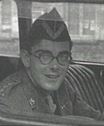George, who died on 6 December 2002 aged 80, enlisted in late 1941, attended OCTU for RAC and was commissioned in February 1943.

He served briefly with the Royal Scots Greys on active service in Italy before transferring to his father’s regiment, 8th KRI Hussars who had returned in December 1943 after nearly ten years in the Middle East, at West Toft’s camp, Thetford in February 1944.
His father, Capt GA Atkinson-Willes, was an 8th Hussar 19111923, seconded as Adjutant of the Ayrshire Yeomanry on 1 September 1922 and died in August 1924 from peritonitis when George was one.
He was brought up at his grandmother’s house near Haslemere and went to Winchester from 1936-41. When he was 16 his mother remarried; to Brig John Van der Byl DSO of Elsenwood near Camberley who was Colonel of 8th Hussars 1930-48.
In early 1944 plans were being made for D-Day and the 8th Hussars moved to Bognor. The main party crossed to Normandy on D+3 but George was in ‘C’ Squadron under Maj Huth who left on D+6 arriving on the beaches at Arromanche the next day.
Fighting their way through France that summer, it was at St Pol on 2 September that George was severely wounded in the leg by shrapnel and had to be evacuated. After being fitted with a tin leg he went to BAOR and returned to the Regiment.
At Lingen, where he became Intelligence Officer, he was able to swing his tin leg very accurately and it became his personal weapon.
This may account for numerous visits to the LAD for leg maintenance. Being an enthusiastic wildfowler since his youth he organised the shooting on the wildfowling marshes at Aschendorf with great success. By January 1948 George had been a ‘test case for servicemen with similar injuries to be able to stay in the Army. The decision went against him.
George then joined Lloyds in 1948 through the introduction of his step-uncle AJ Whittall, City of London Yeomanry (Sharpshooters) 1949 and became a member of Lloyds in 1950. He did not take to working in London and commuting was tricky.
With 8th Hussars in Leicester his former Commanding Officer, Lt Col Goulburn, insisted on his returning each winter to organise the wildfowl shoots. During the year he spent many weekends lying in ditches observing geese which fostered his serious interest. It was during this period that he was struck down with polio.
With his shooting background, he was able to provide guidelines for the wise use of wetlands and their birds, was appointed national organiser of the duck counts and in 1954 joined the research team of the Wildfowl Trust at Slimbridge, Gloucestershire, which had been established by Peter Scott. 1954 proved to be a special year as George married Nina Fletcher, an Australian, who was Peter Scott’s secretary.
In 1963 the monograph ‘Wildfowl in Great Britain’ was published, George being the editor and main author with a second even more erudite edition printed later. He became the international coordinator on behalf of the International Wildfowl Research Bureau but possibly his most important contribution was work on the Wetland Convention in 1971 when an agreed text was signed by 18 countries at Ramsar on the Caspian coast of Iran. Strict requirements are needed regarding bird population to give a wetland international importance and to justify inclusion on the Ramsar List.
During all his time at Slimbridge, George never lost his great interest in the 8th Hussars. When the Regimental museum was being set up at Eastbourne he produced numerous items to exhibit. These were mostly Atkinson-Willes or Van der Byl possessions. One unusual item, a cannonball picked up on the field of Balaklava soon after the Charge, came via the step-uncle who introduced him to Lloyds.
George was an immensely likeable character, with a great sense of humour and the strength of will to overcome his wartime injury and subsequent polio. He was a generous and entertaining host and a true 8th KRI Hussar.


